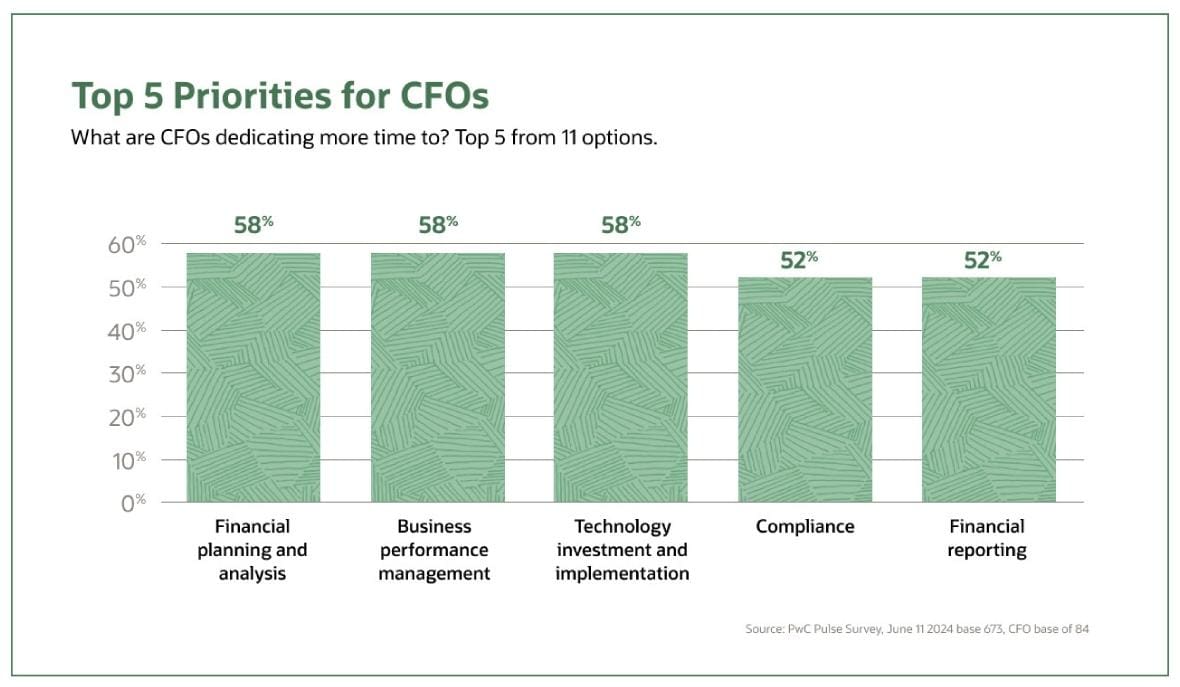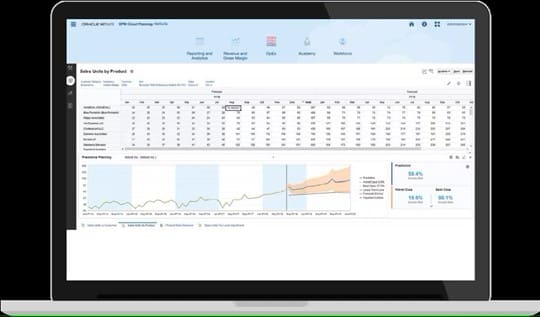Without the ability to peer through time, business leaders may struggle with forward-looking decisions, like how best to allocate resources, manage risk, or expand a product line. However, while no one can perfectly predict what will happen, businesses can use their data to model realistic scenarios that help them select the best options.
Creating reliable financial forecasts requires careful analysis of historical data, current market conditions, and potential future scenarios. This article explores the fundamentals of financial forecasting—which, by definition, results in an educated prediction, subject to the usual disruptive external forces and human predilection for either irrational exuberance or excess pessimism. But calibrating a forecast to account for these variables is possible. Whether you’re developing your first forecast or looking to improve your existing processes, the practical steps and strategies you’re about to learn can enhance your business’s financial planning capabilities.

Key Takeaways
- Financial forecasts predict businesses’ future performance by analyzing historical data, market trends, and economic indicators.
- Analysts regularly review and update their forecasts throughout the financial period to maintain relevant and accurate predictions, especially when market conditions change or new opportunities arise.
- Modern financial planning software can help overcome common forecasting challenges by automating data collection and providing real-time insights.
What Is Financial Forecasting?
Financial forecasting is a strategic process that businesses use to predict future financial performance. Forecasts are developed by finance leaders and consumed by business managers, investors, and other key stakeholders. These tools typically leverage historical actuals, external market and economic factors, and strategic internal plans to develop one or more scenarios of how a company may perform in the presence of future variables. For example, a forecast can alert business leaders to possible future changes in revenue and expenses so that they may act proactively—such as by staffing up or acquiring more inventory—and set financial expectations appropriately.
Financial forecasts are developed from pro forma financial statements. Pro forma financial statements present historical actual and future estimates of a company’s performance.
Pro Forma
| The effects of a future transaction on past financial statements. Answers the question “If we had made this transaction earlier—say, bought a competitor or key supplier—the effect on our financial statement(s) back then would have been.” |
Pro formas typically include the income statement, balance sheet, and statement of cash flows.
The Income Statement
The income statement portrays a company’s profit or loss over a specified period. Financial forecasts indicate the implication of potential variables on revenue, cost of goods sold, expenses, and other factors that could affect a company’s bottom line. For example, a pro forma income statement might forecast how a planned expansion or new product launch could impact revenue and profit margins over the next two quarters.
The Balance Sheet
The balance sheet shows a company’s assets, liabilities, and shareholders’ equity, providing a snapshot of its financial position at a specific point in time. Forecasts may look at how factors such as cash collections, amounts owed to suppliers, or financing through debt or equity may affect the company’s overall financial standing at various points in the future.
The Statement of Cash Flows
The cash flow statement is plain and simple: How much cash do you plan to have coming in and going out at a given point in the future? Both the income statement and balance sheet forecasts will help determine future cash projections that are critical to running a business—or help companies determine when they may run out of cash.
Why Is Financial Forecasting Important?
Financial forecasting is important because it allows businesses to predict the impact of potential strategies on their financial stability and growth, creating a more agile and responsive organization. This flexible, future-focused approach to decision-making empowers modern businesses to stay competitive during economic uncertainty. Indeed, 71% of small business owners ranked the economic environment among their top five stressors, according to the “U.S. Bank 2024 Small Business Perspective” report.
Financial forecasts also enhance other planning processes, from anticipating cash flow needs and setting revenue targets to planning capital expenditures and obtaining new funding sources. For example, a manufacturer might perform forecasting to determine when to invest in new equipment based on projected demand, while a service business might do so to time its hiring decisions. Both companies may take these forecasts to investors, lenders, or creditors as a critical piece of their requested funding application to demonstrate their market position and growth potential.
Types of Financial Forecasts
Businesses often adapt their financial forecasts to serve different needs and time frames. While many forecasting methods can be used independently for ad-hoc estimates, organizations may combine multiple types of forecasting to create comprehensive views of their financial futures. Here are four primary forecasts businesses typically use.
1. Sales Forecasting
Sales forecasting projects future revenue by analyzing historical sales data, customer behavior patterns, and market and seasonal trends. Businesses use these forecasts to plan inventory levels, staffing needs, and marketing initiatives while setting realistic sales targets for different products and services. These revenue targets allow financial planners to establish a baseline for the incoming funds that will be used to cover bills and expansion efforts.
2. Cash Flow Forecasting
Cash flow forecasting predicts the timing and amount of cash inflows and outflows over an upcoming period. These forecasts encourage businesses to maintain adequate liquidity for day-to-day operations, such as for wages, supplies, and other financial obligations. Even a company with record sales can experience cash flow issues if customers are slow to pay or unexpected financial pressures arise. Therefore, if a cash flow forecast identifies potential shortfalls, businesses can seek cash injections, such as investors, loans, or credit lines, all of which may require forecasts before granting approval.
3. Historical Forecasting
Historical forecasting uses past performance data to predict future outcomes, assuming similar patterns will continue. This method analyzes trends, seasonality, and growth rates from previous periods to extrapolate future results while accounting for any known or expected changes in business conditions. While historical data provides a strong foundation for forecasting, businesses must remember that past performance doesn’t necessarily apply to the future, especially if market conditions and demand change over time.
4. Budget Forecasting
“Budget forecasting” is a misnomer often used in business, so let’s set the record straight: Budgeting and forecasting are two separate processes that work together in financial planning. Budgeting combines projected revenues with anticipated expenses to create a balanced financial map for future periods. This process, which involves input from various departments, promotes effective resource allocation and cost control. Forecasting, on the other hand, provides ongoing financial projections based on current data and trends. By integrating budgeting with ongoing forecasting, businesses can identify variances early and adjust their financial strategies.
Forecast vs. Actuals
A critical part of the month, quarter, and annual close processes is to assess how actual financial performance compares with forecasts. At the beginning of the financial period, many businesses create multiple forecasts based on different variances, such as current trajectory growth and best-case and worst-case scenarios. While most businesses would prefer if reality matched their best-case scenarios, it’s rare that all variables perfectly align with estimated projections. When conducting detailed comparisons at the end of the forecasted period, management reviews each variance and assesses what occurred that was not reflected in the initial estimates. External factors like economic upswings or downturns often impact actual performance, and significant disruptions will likely require revising traditional forecasts mid-cycle. This process, called reforecasting, uses actuals to reassess and update forecasts on a rolling basis, factoring in as much real-time data as possible to show what is actually happening at the company. Smaller disruptions or shifts may not justify a full reforecast, and it may be wiser to save the resources and just learn from the variances for next time.
Traditional vs. Rolling Forecasts |
||
|---|---|---|
| Traditional Forecasting | Rolling Forecasting | |
| Fixed financial plan calculated for a set period of time, typically one year, that uses historical observations to estimate future business metrics. | A “live” financial plan that is regularly updated throughout the year to reflect changes. | |
| Calendar-based (annual, quarterly) | Event-based with real-time adjustments to calendar forecasts | |
| Fixed targets (sales/profit, other KPIs) | Dynamic adjustments to targets based on external/internal events | |
| Resource allocations are rigid | May trigger reallocation of resources based on dynamic targets | |
| Manual, account-based and often linked to accounting cycles | Business-driver-based and connected to operations | |
Budgeting vs. Financial Forecasting
As mentioned above, budgeting and forecasting are two distinct tools used by management to evaluate performance. A budget is a plan that quantifies what a business wants to achieve over a specified period. A financial forecast is different in that it leverages variables to estimate future outcomes, whether they’re desirable or not. In other words, a budget is management’s plan, while a financial forecast is a prediction.
The tools also differ in how they’re used. The budgeting process is typically performed before the end of the fiscal year. It’s a collaborative process among a number of stakeholders, where management sets achievable goals based on past performance and known business changes for the coming year and determines where to allocate resources. Throughout the year, actual performance is evaluated against the baseline budget, and variances are analyzed.
Forecasting, on the other hand, does not measure performance based on variances. Forecasts are estimations of future performance based on variables and scenarios. They’re frequently updated when new information is brought to management’s attention and are used to strategize and inform budgets. A complete financial forecast includes projected revenue, assets, liabilities, cash flows, and operational key performance indicators (KPIs). For example, if a competitor opens up down the street, the management team may run various forecasts to predict how this event could affect future revenue. They may choose to budget for additional marketing in future months to keep new customers coming in the door and revenue consistent. The tools work hand in hand.
Financial Forecasting vs. Financial Modeling
Forecasts rely heavily on financial modeling to process complex variables and scenarios to predict future outcomes. These financial models are analytic tools that evaluate potential outcomes by weighing different scenarios based on their probability and potential impact, transforming raw data and assumptions into actionable insights that inform the forecasting process.
Financial modeling typically incorporates two complementary approaches: quantitative and qualitative. Quantitative models analyze statistical data from various sources, including industry benchmarks, economic indicators, and core financial metrics, such as GDP growth and price-to-earnings ratios. Conversely, qualitative models consider factors that can’t be measured objectively yet impact financial performance, such as changes in consumer preferences, shifts in market sentiment, or collective decision-making by all stakeholders. By combining both approaches, businesses can create more comprehensive and reliable forecasts that consider both measurable data and important contextual factors.
Benefits of Financial Forecasting
Financial forecasting allows management to predict how a business will perform. By brainstorming variables, leadership teams can create scenarios that prepare them to act proactively and plan accordingly. For example, by forecasting revenue over the next 18 months, a business could plan how it will respond if projected economic indicators do or do not manifest.
By using both assumptions and drivers, companies can plan for a multitude of scenarios and how they might affect various areas of the business, including:
- Future expansion initiatives, including cash flow projections and staffing requirements.
- New product or service launches to diversify revenue streams and capture market opportunities.
- Demand planning to optimize inventory levels and reduce carrying costs.
- Customer acquisition and retention projects to grow the business.
- Cash flow management to ensure adequate liquidity for operations and investments.
- Workforce planning to align staffing levels with projected business needs.
Beyond operational planning, effective forecasting empowers businesses to maintain their competitive advantage. By using multi-scenario forecasts, businesses can respond to market changes quickly while mitigating risks or negative consequences of these pivots. For example, if a forecast predicts an upcoming market downturn, companies can proactively adjust their spending, preserve cash, or seek additional funding before conditions worsen. Similarly, when a forecast suggests growth opportunities, businesses can make sure they have the resources and infrastructure in place to effectively capitalize on these opportunities.
Challenges of Financial Forecasting
Financial forecasts can guide better decision-making—if they’re based on complete, current, and accurate models and data. Unfortunately, many businesses struggle with capturing data that’s deep and timely enough to create forecasts that they feel confident about.
Why is that?
Plenty of variables can affect a forecast’s accuracy, not just economics. Often, the most difficult factor is the wide range of data that a company needs to create effective forecasts in the first place. Many companies use a multitude of systems to run their businesses, such as dedicated platforms for customer relationship management (CRM), inventory management, ecommerce, and accounting. If these systems aren’t integrated, the only way to create a forecast is to download data from each one and aggregate everything in Excel. Once data is aggregated, it can be manipulated and formulas applied; only then can forecasts be analyzed.
Several challenges can arise during this process.
- Static data: The moment data is downloaded into Excel, it becomes static. But businesses aren’t static. Data changes. Transactions are reversed and altered. Material changes to, for example, inventory levels made after that data is downloaded means that forecasts may not be based on the most complete and accurate information.
- Siloed data: Data sources used in forecasts often don’t “talk” to one other. Rather, data is manually entered, and changes made in one system may not be reflected in others. This can create several problems, among them the possibility of duplicate records and the inability to reconcile transactions. A lack of “truth” makes it hard to feel confident that forecasts are built on accurate information. This challenge is underscored by findings from the Citizens Financial Group 2024 Business Outlook Report, which reveals that 64% of surveyed companies that rely on financial tools plan to consolidate what they use into one centralized data platform in the upcoming year. They anticipate that doing so will lead to faster growth and expansion over the next five years.
- Disconnect from business impact: A manual forecasting process is difficult to manage, causing the finance team to waste time just ensuring accuracy or fixing errors. That leaves little time to understand the specific issues impacting business units.
- Transparency issues: With crucial information stuck on separate files across the organization, there’s no central repository of information for everyone to work from. This lack of transparency often translates into a lack of trust between business units and finance leaders.
- Errors: Any process with many manual steps has an increased propensity for error and version control. The standard forecasting process in Excel has a number of manual steps and typically caps the process off with complex formulas. However, one small error in a formula—or any of the aggregation and manipulation steps—could have significant effects on forecasting.
These challenges just add to the reasons so many executives don’t feel confident in their companies’ forecasting processes.
8 Steps to Creating Your Financial Forecast
Creating a useful and realistic financial forecast can be an intimidating and complex process. Combining a company’s financial data with a broad range of other financial and market data requires a deliberate approach to help ensure nothing is forgotten or overlooked. Here are eight straightforward steps financial teams can follow to develop a comprehensive financial forecast.
- Align the process of financial forecasting with broader financial planning activities, including modeling and budgeting. This alignment is often aided by a unified business solution or integration tools that create consistency across all activities and support an array of planning initiatives. Through careful planning and collaboration, stakeholders can ensure forecasts include the metrics and targeted analysis required to achieve long-term organizational goals and monitor ongoing progress.
- Gather financial statements from recent periods. These documents—including income statements, balance sheets, and cash flow statements—provide the historical data forecasters will need to understand the business’s financial patterns and trends. It may also be helpful to gather prior financial forecasts to see what they accurately predicted and where they missed the mark. Pay special attention to seasonal variations, one-time events, and any anomalies that might affect future projections.
- Establish a methodical approach for maintaining and analyzing financial data, best housed in a comprehensive database that the forecasting team can reference going forward. This approach includes creating standardized templates, establishing clear data collection protocols, implementing regular review cycles, and training staff on this approach. A well-documented methodology facilitates period-over-period analysis through apples-to-apples comparisons to consistently improve forecasts.
- Create a pro forma income statement that projects expenses and revenues. This forward-looking document should incorporate historical trends while accounting for anticipated changes in costs and earnings. Pay particular attention to KPIs that significantly affect the bottom line, such as expected sales or . If the pro forma income statement will be used to seek funding, include detailed profit-and-loss projections that showcase operational performance and help investors calculate important figures, such as earnings before interest, taxes, depreciation, and amortization (EBITDA).
- Build a pro forma cash flow statement that outlines the business’s opening balance, anticipated cash sources, and projected outgoing expenditures to predict net cash flow for the forecasted period. Include cash flows from all business activities—operating, investing, and financing—to create a detailed view of future liquidity. This projection helps decision-makers invest surplus cash without exposing the business to unnecessary risk from cash shortfalls.
- Create a balance sheet that projects the business’s current and noncurrent assets; total liabilities, such as accounts payable and outstanding loans; and total equity. This statement forecasts the company’s financial position and ability to meet obligations. Pro forma balance sheets should also consider any expected changes to working capital over the projected period.
- Analyze your financial data by assessing the relationships between chosen metrics and performance, identifying trends that might impact the business’s finances. Additionally, document correlations between various business drivers and financial outcomes as well as assumptions that informed the analysis. This step validates successful forecasting methods while providing critical details on missed estimates that can improve future predictions.
- Consistently reevaluate the financial forecast, especially as business conditions change or immediately following events that may significantly impact the business. Regular review ensures forecasts remain relevant and accurate, while also documenting which forecasting methods work best for the company. Companies that implement a formal review schedule should also be open to conducting additional reviews when needed, such as after an unexpected price hike by a supplier or a new competitor enters the market.
How Frequently Should You Perform a Financial Forecast?
Businesses often generate or update monthly forecasts during their regular financial close process, incorporating the most recent data into their projections. However, companies in rapidly changing industries or those experiencing significant growth or financial uncertainty might benefit from more frequent adjustments. Some businesses conduct weekly or even daily forecasts for some metrics, including cash flow.
While regular updates are important, businesses should also conduct more comprehensive forecast reviews when significant events occur, such as entering new markets, launching products, or experiencing financial disruptions. This flexible approach ensures that forecasts remain relevant and useful for decision-making, especially for new endeavors without historical precedent or data. However, more frequent forecasting can strain company resources when handled manually, so businesses should weigh their staffing and technological capabilities to find the balance that works for them.
Financial Forecasting Tools and Technology
Organizations must overcome hurdles created by time-consuming and error-prone systems to create timely and accurate financial forecasts. NetSuite’s financial planning software minimizes these challenges by automating labor-intensive forecasting and budgeting processes, providing real-time perspectives that leaders may consider for informed decision-making. Businesses can use NetSuite’s platform to streamline their financial forecasting process and, thus, spend more time developing and applying data-driven strategies, rather than filling gaps and crunching numbers.
NetSuite’s unified platform eliminates data silos by integrating financial, operational, and sales systems to unlock real-time data analytics and reduce manual entry and human error. Analysts can leverage the cloud-based software’s built-in rolling forecasts and what-if scenario modeling to quickly adjust projections based on changing conditions, wherever and whenever they need to. And after forecasts are created, customizable dashboards and reporting tools provide stakeholders with clear visualizations of key metrics and trends. This comprehensive approach to financial planning allows businesses to focus on growth with confidence, even during periods of financial and market volatility.

Financial forecasts provide businesses with strong foundations for strategic planning, but they’re only as effective as the processes, tools, and data they rely on. By following established forecasting methods, leveraging modern financial planning software, and regularly updating projections as real results come in, businesses can create more accurate and actionable forecasts. This data-driven approach to financial planning helps organizations anticipate challenges, grab opportunities, and maintain stability to stay competitive, especially during periods of uncertainty or market change.
Financial Forecasting FAQs
What is the most difficult aspect of preparing a financial forecast?
Forecasters constantly struggle with gathering and maintaining accurate, up-to-date data from multiple sources. The inability to integrate data from various departments and systems effectively can create inconsistencies and outdated information. Additionally, accounting for quantitative factors, such as historical performance and market trends, and qualitative factors, such as changing consumer behavior or potential regulatory changes, can pose challenges.
How does financial forecasting relate to financial planning?
Financial forecasting is a key component of the broader financial planning process, providing data-driven predictions that inform a business’s strategies for meeting its financial goals. Forecasts help organizations determine whether their financial plans are achievable based on current trends and market conditions.
How long should a financial forecast be?
The appropriate time frame for a financial forecast depends on the business and market conditions. Short-term forecasts typically cover one to three months and focus on immediate operational needs, such as cash flow and inventory. Medium-term forecasts often extend one to two years and aid annual budgeting and resource allocation. Longer-term forecasts, such as three-to-five-year projections, are often used for broader strategic planning and major investments. But it’s important to remember that a forecast’s accuracy typically decreases the further out it projects. Therefore, predictions should be adjusted and realigned as real results come in.









